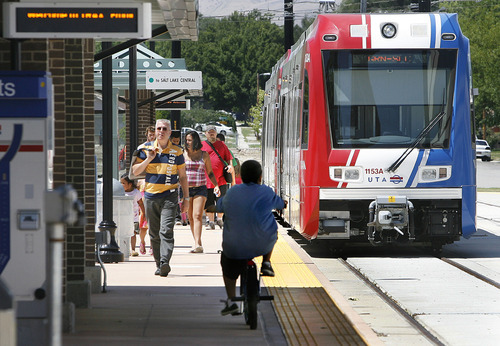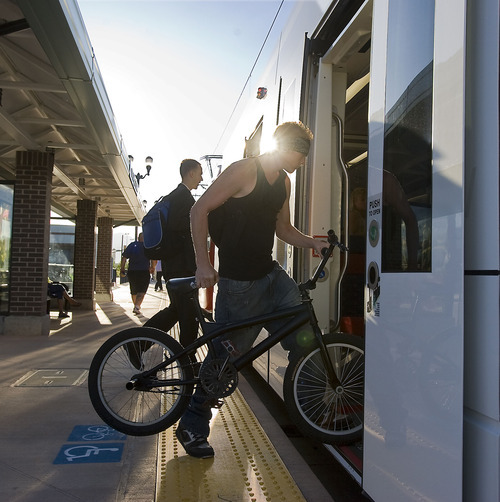This is an archived article that was published on sltrib.com in 2011, and information in the article may be outdated. It is provided only for personal research purposes and may not be reprinted.
Tauveli Taulanga said he often rode a fast bus from his home in West Valley City to work at the LDS Church Office Building in downtown Salt Lake City. But that fast bus was canceled with the opening of the new West Valley City TRAX extension, and the bus now takes him instead to the beginning of that line.
"Sometimes that fast bus hit traffic and wasn't so fast. This will not hit traffic," he said pointing at the TRAX train. He adds that sometimes he drove to work, but sees TRAX as more economical. "I had to fill up twice a week when I did that. I drive an SUV."
Taulanga was among thousands of commuters adjusting to changes Monday with the opening of the West Valley City and Mid-Jordan TRAX extensions. The two lines nearly doubled the mileage of TRAX, but they also led to cancellation of 10 percent of Utah Transit Authority bus service to save money, plus alteration of 90 percent of bus routes to mesh with the new TRAX offerings.
Also, TRAX lines started using a new color-coded system as the extensions opened. The red line travels between the Daybreak area of South Jordan to the University of Utah. The green line travels from West Valley City to downtown Salt Lake City. The blue line travels from Sandy to downtown. Disappearing were some old TRAX routes directly between Sandy and the University of Utah, and from the university to downtown.
Even with all the changes, the first day of commuter service in the new system appeared to be running smoothly for the most part. However, during the evening commute one of the brand new TRAX train cars broke down on the section of track shared by all lines — and caused 15-minute rush hour delays on all of them. Delays hit for about an hour at the height of rush hour as northbound and southbound lanes had to share one track.
But, for much of the day, "Everything has been smooth," said UTA Chief Planning Officer Matt Sibul, who was wearing a neon green vest and volunteering to help people at the Courthouse Station, now a main transfer point between all lines.
UTA had expected that some people might not get the message that the Gallivan Station would no longer be a main transfer point for trains headed to the University of Utah. Matt Carter, a UTA volunteer helping people at Gallivan Center, said he met only three people who had a problem with that Monday morning.
"They knew they had to transfer at Courthouse, but accidentally got on a green line train there instead of a red line. So they got off here [at Gallivan]. There was another train already here at the platform headed to Courthouse, so they just jumped on it and didn't lose much time," he said.
Lori Johnson, who parked at the West Valley Central Station for TRAX and buses, noted that parking lot was "a lot more full" there than usual at 7:30 a.m. Previously, she had parked there to catch a fast bus, now canceled, to the University of Utah. On Monday, only a few spots were still left at that parking lot with more people attracted to the new TRAX line.
"My commute will take about the same amount of time," using TRAX instead of a now-canceled fast bus, Johnson said. "But I have to transfer once now downtown, where I didn't have to do that before."
Chris McLaughlin, of Taylorsville, said his commute to an industrial park in West Valley City will take about 10 minutes longer now, because what had been a bus directly between home and work now dead-ends at the West Valley Central Station. "It's only 10 minutes, though. I guess it's OK," he said.
Nathan Purser, of Magna, said his commute to Primary Children's Medical Center will be at least that much shorter. He said his wife would drop him off at a TRAX station on the Sandy line on her way to work, but now drops him in West Valley City and it shortens the commute for both of them.
University of Utah student Randi Frehner, of Riverton, has been waiting anxiously for the opening of the new Mid-Jordan line. Until this week, it had taken her 25 minutes to reach the Sandy TRAX station from her home. She can reach the Daybreak stop in half that time, and it takes her directly to the university. "This is really convenient for me," she said.
Amy Raugust, of Kearns, said she is happy to trade her car for a train. "I'm sick of driving," she said. "It takes forever to get from where I live to downtown. It is not worth the hassle. I'm all for trying this," she said with a book on her lap while riding the Mid-Jordan extension. Many others were tapping on computers or chatting on cell phones as they rode.
Steve Hills said riding the Mid-Jordan extension instead of driving would add seven minutes to his commute. But he says it would cut gasoline costs and leave his one family car to his wife. He said he planned to ask his employer whether it would offer discount passes to make it even more affordable. "We'll see what happens," he said.
On the trains Monday, more people than usual were seen grabbing schedules and checking times on how to make connections with buses. Volunteers at the end of TRAX lines were urging people not to run to trains that commuters saw waiting as they parked or got off buses. "Just walk. You have five minutes before it leaves," a volunteer told people at the West Valley Central station.
Green line TRAX trains in West Valley were not too crowded, with plenty of seats available. Longtime, more established blue line trains from Sandy, however, were standing-room only as usual.
UTA General Manager Michael Allegra had spent much of the morning riding trains himself. "It's been smooth. We haven't seen any major problems. The trains are on time, and everything is good so far," he said between catching trains at the Courthouse Station.
He said the only major complaint UTA had in the first two days of the new TRAX lines was that UTA had decided to start its Sunday service later to save money. "We had a lot of calls from people who want it to start earlier," he said.

















